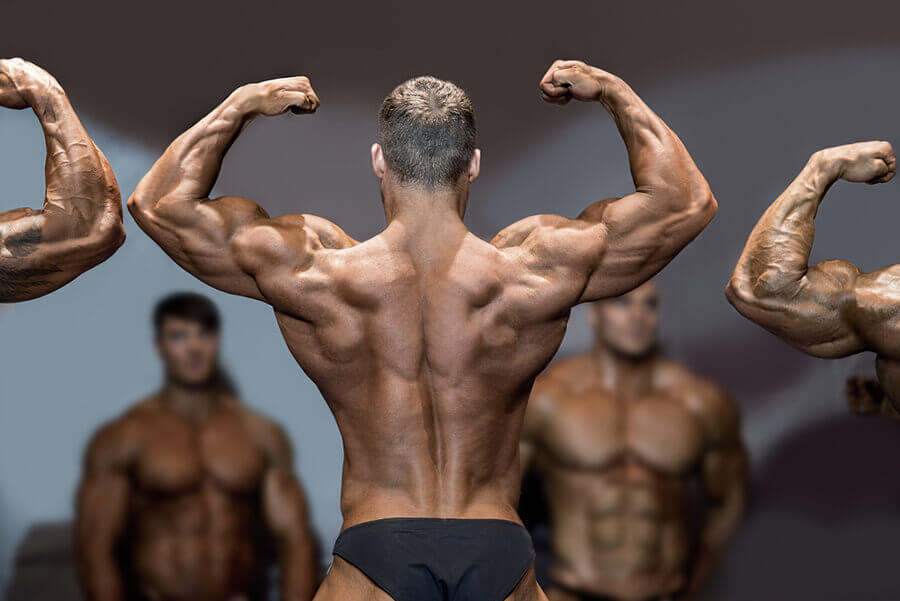Why Bodybuilding can be Dangerous: Understanding Risks

Bodybuilding can be dangerous even though it’s been gaining popularity as a sport. Many researchers and doctors claim that bodybuilding is a danger when it isn’t practiced responsibly. What factors should be taken into account about this discipline? Here’s everything you need to know about it.
For starters, it’s important to establish the difference between bodybuilding and building your body. That’s right: building your body is the tendency to create large and marked muscles with training and healthy eating.
On the other hand, Bodybuilding as a sport involves greater efforts and usually implies having to take supplements to achieve your physical objectives more quickly. In contrast, the former can be a positive lifestyle.
Bodybuilding can be dangerous: as a sport?
As a method of competition and a sport, bodybuilding is a discipline that demands intense training. This training involves anaerobic work and a strict diet.
The goal of bodybuilding is to achieve the greatest possible muscular hypertrophy. This means you’ll be growing your muscles to the best of your abilities and then show them to a judging panel in a competition.
In bodybuilding competitions, judges evaluate your muscles’ definition, their size, symmetry and the poses that the contestants adopt to show them off.
Bodybuilding is a physical activity that also demands a catwalk to perform. The presentations are made in gyms or auditoriums. There’s a place for bodybuilders, another for the jury and, of course, a proper area for the public.
Positive consequences of bodybuilding
Before going into why bodybuilding can be dangerous, it’s important to make a few exceptions. After all, it’s gained popularity because it does have some positive consequences. Whether you join it for sports or aesthetic purposes, there are some good things that can come out of it. Here are a few of the benefits you might enjoy from bodybuilding training:
- Gain strength, endurance and muscular flexibility.
- Muscle atrophy is prevented.
- It helps avoid joint pain.
- It reduces the possibility of suffering injuries and falls since it improves balance.
- Combats a sedentary lifestyle.
- Gain muscle volume.
Why can bodybuilding be dangerous?
There are two fundamental reasons why experts say that bodybuilding can be dangerous, especially when the athlete is a newbie or starts training without an expert’s advice.
Here are some of the reasons why bodybuilding can be dangerous:
Extreme physical demands
Bodybuilding demands enormous physical intensity. This involves a lot of time investment and a total lifestyle change. Because of this, many bodybuilders leave their work, relationships and other obligations in second place.
Diminished mental health: why bodybuilding can be dangerous
Due to the very nature of intense training and isolation from non-bodybuilders, many practitioners fall into unhealthy mental trends. This can appear as excessive narcissism or body dysmorphia, as well as eating disorders. The strong physical demands can easily transform into unhealthy excesses that can be very dangerous for your life.

Substance abuse among bodybuilders
The use of certain substances is one of the main points of contempt against bodybuilding. In the competitive version of this sport, many people use anabolic agents to enhance performance.
Although anabolic agents are positive against pathologies such as osteoporosis, some anemias, and recovery after an operation, their indiscriminate use entails significant damage to health.
This is such an extended issue that in the United States, Congress legislated the use of anabolic agents. Their use is restricted and their consumption is, in certain ways, treated in a similar way to cocaine.
Bodybuilding can be dangerous: negative effects of substance abuse
Here are some of the negative effects of steroid abuse:
- Hydrosaline retention: this is a fancy name to say that your body will retain water and sodium. In turn, this can be very bad for hypertensive people.
- Problems in the endocrine system: anabolic agents can cause hormonal irregularities, modification of the uterine mucosa in women and even hemorrhages in the area.
- Virilization: women experience changes in voice tone, acne, and hypertrophy throughout the body. This can have a positive impact on the look of muscles, but it can also affect the breasts and clitoris.
- Hepatotoxicity: when taken in higher doses than recommended, anabolic agents can damage liver function.
- Decreased testosterone production: this can cause different problems among men. One of the worse consequences of anabolic agents is infertility because the testicles stop functioning normally.
- Prolonged catabolic state: if the bodybuilder suddenly stops taking the supplements, their body would have a very hard time resuming its normal functioning. Then, the individual may feel weak, depressed and have a low libido.
Of course, it’s important to highlight that if you’re pregnant, these substances are totally contraindicated. You shouldn’t take anabolic agents if you have renal, hepatic or cardiac insufficiency; prostate carcinoma or when combined with oral anticoagulants or antidiabetic medications.

Other ways in which bodybuilding can be dangerous
On top of steroid consumption, there are other dangerous “supplements” that are very common among the bodybuilding community. Some people inject their muscles with soybean oil in order to boost muscle growth.
Even though this effectively causes the muscles to grow, it isn’t because of a healthy increase in muscle mass. Instead, injecting soybean oil in your muscles leads to very serious side effects, such as muscular atrophy, necrosis of muscle fibers, the appearance of pus and hemorrhages and even cardiac arrest.
Conclusion: is bodybuilding dangerous?
As with so many other instances of life, we can affirm that the key is in balance. Bodybuilding can be dangerous when there’s an excessive obsession to grow muscles at all costs and without taking care of one’s own health and other aspects of life.
However, bodybuilding can also be a positive practice to keep you fit, feel good and prevent the body from atrophying and losing mobility over time. In short, it always depends on the use that the human being makes of the tools at his disposal. If you’re interested, give it a try!
Bodybuilding can be dangerous even though it’s been gaining popularity as a sport. Many researchers and doctors claim that bodybuilding is a danger when it isn’t practiced responsibly. What factors should be taken into account about this discipline? Here’s everything you need to know about it.
For starters, it’s important to establish the difference between bodybuilding and building your body. That’s right: building your body is the tendency to create large and marked muscles with training and healthy eating.
On the other hand, Bodybuilding as a sport involves greater efforts and usually implies having to take supplements to achieve your physical objectives more quickly. In contrast, the former can be a positive lifestyle.
Bodybuilding can be dangerous: as a sport?
As a method of competition and a sport, bodybuilding is a discipline that demands intense training. This training involves anaerobic work and a strict diet.
The goal of bodybuilding is to achieve the greatest possible muscular hypertrophy. This means you’ll be growing your muscles to the best of your abilities and then show them to a judging panel in a competition.
In bodybuilding competitions, judges evaluate your muscles’ definition, their size, symmetry and the poses that the contestants adopt to show them off.
Bodybuilding is a physical activity that also demands a catwalk to perform. The presentations are made in gyms or auditoriums. There’s a place for bodybuilders, another for the jury and, of course, a proper area for the public.
Positive consequences of bodybuilding
Before going into why bodybuilding can be dangerous, it’s important to make a few exceptions. After all, it’s gained popularity because it does have some positive consequences. Whether you join it for sports or aesthetic purposes, there are some good things that can come out of it. Here are a few of the benefits you might enjoy from bodybuilding training:
- Gain strength, endurance and muscular flexibility.
- Muscle atrophy is prevented.
- It helps avoid joint pain.
- It reduces the possibility of suffering injuries and falls since it improves balance.
- Combats a sedentary lifestyle.
- Gain muscle volume.
Why can bodybuilding be dangerous?
There are two fundamental reasons why experts say that bodybuilding can be dangerous, especially when the athlete is a newbie or starts training without an expert’s advice.
Here are some of the reasons why bodybuilding can be dangerous:
Extreme physical demands
Bodybuilding demands enormous physical intensity. This involves a lot of time investment and a total lifestyle change. Because of this, many bodybuilders leave their work, relationships and other obligations in second place.
Diminished mental health: why bodybuilding can be dangerous
Due to the very nature of intense training and isolation from non-bodybuilders, many practitioners fall into unhealthy mental trends. This can appear as excessive narcissism or body dysmorphia, as well as eating disorders. The strong physical demands can easily transform into unhealthy excesses that can be very dangerous for your life.

Substance abuse among bodybuilders
The use of certain substances is one of the main points of contempt against bodybuilding. In the competitive version of this sport, many people use anabolic agents to enhance performance.
Although anabolic agents are positive against pathologies such as osteoporosis, some anemias, and recovery after an operation, their indiscriminate use entails significant damage to health.
This is such an extended issue that in the United States, Congress legislated the use of anabolic agents. Their use is restricted and their consumption is, in certain ways, treated in a similar way to cocaine.
Bodybuilding can be dangerous: negative effects of substance abuse
Here are some of the negative effects of steroid abuse:
- Hydrosaline retention: this is a fancy name to say that your body will retain water and sodium. In turn, this can be very bad for hypertensive people.
- Problems in the endocrine system: anabolic agents can cause hormonal irregularities, modification of the uterine mucosa in women and even hemorrhages in the area.
- Virilization: women experience changes in voice tone, acne, and hypertrophy throughout the body. This can have a positive impact on the look of muscles, but it can also affect the breasts and clitoris.
- Hepatotoxicity: when taken in higher doses than recommended, anabolic agents can damage liver function.
- Decreased testosterone production: this can cause different problems among men. One of the worse consequences of anabolic agents is infertility because the testicles stop functioning normally.
- Prolonged catabolic state: if the bodybuilder suddenly stops taking the supplements, their body would have a very hard time resuming its normal functioning. Then, the individual may feel weak, depressed and have a low libido.
Of course, it’s important to highlight that if you’re pregnant, these substances are totally contraindicated. You shouldn’t take anabolic agents if you have renal, hepatic or cardiac insufficiency; prostate carcinoma or when combined with oral anticoagulants or antidiabetic medications.

Other ways in which bodybuilding can be dangerous
On top of steroid consumption, there are other dangerous “supplements” that are very common among the bodybuilding community. Some people inject their muscles with soybean oil in order to boost muscle growth.
Even though this effectively causes the muscles to grow, it isn’t because of a healthy increase in muscle mass. Instead, injecting soybean oil in your muscles leads to very serious side effects, such as muscular atrophy, necrosis of muscle fibers, the appearance of pus and hemorrhages and even cardiac arrest.
Conclusion: is bodybuilding dangerous?
As with so many other instances of life, we can affirm that the key is in balance. Bodybuilding can be dangerous when there’s an excessive obsession to grow muscles at all costs and without taking care of one’s own health and other aspects of life.
However, bodybuilding can also be a positive practice to keep you fit, feel good and prevent the body from atrophying and losing mobility over time. In short, it always depends on the use that the human being makes of the tools at his disposal. If you’re interested, give it a try!
All cited sources were thoroughly reviewed by our team to ensure their quality, reliability, currency, and validity. The bibliography of this article was considered reliable and of academic or scientific accuracy.
- Julián De Hoyos; Alfredo Embid. Efectos indeseables de los esteroides anabolizantes. http://www.amcmh.org/PagAMC/medicina/articulospdf/57Anabolizantes.pdf
- Físico culturismo y fitness. Guía de diseño de instalaciones deportivas. https://waltervillavicencio.com/wp-content/uploads/2018/06/FISICO-CULTURISMO-Y-FITNESS.pdf
- Roberto Fidel Porto Álvarez; Rudbeckia Álvarez Núñez; Mayra Pérez Quintero; Ricardo Hernández Yagudin. Consecuencias del seudofisiculturismo en adolescentes. Hospital Pediátrico Universitario “Eliseo ¨Noel¨ Caamaño”, de Matanzas. http://scielo.sld.cu/pdf/ort/v27n1/ort10113.pdf
This text is provided for informational purposes only and does not replace consultation with a professional. If in doubt, consult your specialist.








